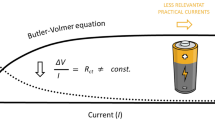Abstract
An electrochemical permeation method was employed to study the diffusion behaviour of hydrogen and deuterium in palladium. Solutions of 0.1 m LiOD (in D2O) and 0.1 m LiOH (in H2O) and their mixtures were used as the catholytes. More than one hundred diffusivity data from 20 palladium membranes were collected. Statistical analysis of these data was made to examine the validity of the reversed isotope dependence for hydrogen diffusion in palladium. It was concluded that the effective diffusivities increased with the concentration of deuterium in the electrolyte. In addition, an in situ experiment was also performed by adding to the cathodic cell an equivalent amount of LiOD solution to the original LiOH solution, or vice versa. Graphical comparison of the corresponding permeation transients showed that the permeation rate increased when deuterium was added to the solution of H2O, and the rate decreased when hydrogen was added to the solution of D2O. This constitutes direct evidence for the higher diffusivity of deuterium than that of hydrogen in palladium.
Similar content being viewed by others
References
C. Wert and C. Zener, Phys. Rev. 76 (1949) 1169.
G. H. Vineyard, J. Phys. Chem. Solids 3 (1957) 121.
Y. Fukai and H. Sugimoto, Adv. Phys. 34 (1985) 263.
J. Amano and D. N. Seidman, J. Appl. Phys. 56 (1984) 983.
A. J. Kumnick and H. H. Johnson, Acta Metall. 25 (1977) 891.
N. R. Quick and H. H. Johnson, Metall. Trans. 10A (1979) 67.
G. Schaumann, J. Volkl and G. Alefeld, Phys. Stat. Sol. 42 (1970) 401.
G. Bomholdt and E. Wicke, Z. Physik. Chem. N.F. 56 (1967) 133.
G. Holleck and E. Wicke, ibid. 56 (1967) 155.
J. Volkl, G. Wollenweber, K.-H. Klatt and G. Alefeld, Z. Naturforsch. 26a (1971) 922.
S. Majorowski and B. Baranowski, J. Phys. Chem. Solids 43 (1982) 1119.
M. A. V. Devanathan and Z. Stachurski, Proc. Royal Soc. A270 (1962) 90.
C. L. Yu and T. P. Perng, Acta Metall. Mater. 39 (1991) 1091.
C. J. Lihn, C. C. Wan, C. M. Wan and T. P. Perng, Fusion Technol., in press.
J. McBreen, L. Nanis and W. Beck, J. Electrochem. Soc. 113 (1966) 1218.
A. Czerwinski and R. Marassi, J. Electroanal. Chem. 322 (1992) 373.
E. Storms and C. Talcott-Storms, Fusion Technol. 20 (1991) 246.
Ted B. Flanagan, J. F. Lynch, J. D. Clewley and B. Von Turkovich, J. Less Common Metals 49 (1976) 13.
Author information
Authors and Affiliations
Rights and permissions
About this article
Cite this article
Lihn, C.J., Wan, C.C. & Perng, T.P. In situ comparison of diffusivities for hydrogen and deuterium in palladium. J Appl Electrochem 25, 61–67 (1995). https://doi.org/10.1007/BF00251266
Received:
Revised:
Issue Date:
DOI: https://doi.org/10.1007/BF00251266




